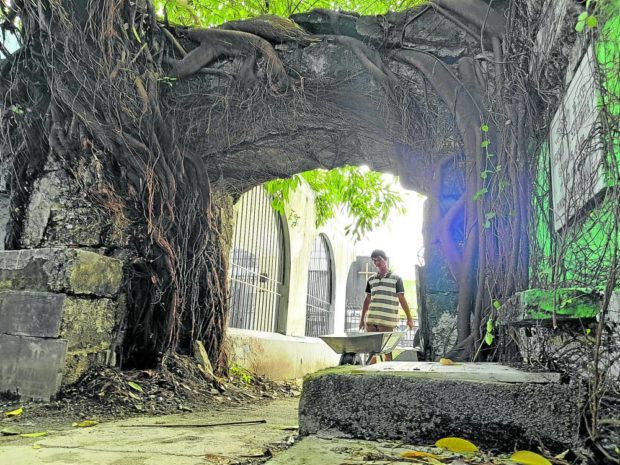
HISTORIC DEMARCATION LINE This centuries-old entrance arch at the Nuestra Señora de la Asuncion Parish public cemetery in Bulakan town, Bulacan, separates the gravesites of personalities from ordinary citizens of the town. The arch, as shown in this photo taken on Wednesday, needs repair, according to local historians. —CARMELA REYES-ESTROPE
BULAKAN, Bulacan—The preservation of the centuries-old arches and other relics inside the public cemetery in this former capital town of Bulacan province will not happen anytime soon as the Catholic Church that owns the property has no resources for the undertaking.
Fr. Javer Mercado Joaquin, parish priest of the Nuestra Señora de la Asuncion Parish Church, said they could not afford to rehabilitate the centuries-old inner entrances and exits of the cemetery since the money generated from the parishioners’ usage of the 400-year-old cemetery was not even enough for grounds upkeep.
The two arches at the cemetery marked the entrances that separated the burial grounds of the rich and Ilustrados (Filipino educated class during the Spanish period) from the poor residents of the town, according to Joey Rodrigo, vice president of the local heritage and historical group Kabesera, quoting a former priest in the town.
For next generation
Rodrigo said the structures must be preserved for the next generations to still experience a glimpse of the past under the Spanish rule.
Perfecto Teodoro Martin, the president of Kabesera, said the Catholic Church should be responsible for ensuring that the structures are preserved.
But Joaquin said the two arches might only require cleaning. Retrofitting at this point could not be done since it could destroy the arches, unless it would be done by experts who could preserve its antiquity.
According to Joaquin, what needed to be rebuilt were the cemetery’s fence and pathways.
“Wala dapat gawin, masisira ang antiquity, linisin lang (There is no need to do anything; it might only destroy its antiquity. It just needs cleaning),” said the priest.
Burial ground of the famous
The public cemetery is situated within the compound of the 444-year-old Nuestra Señora de la Asuncion Parish Church.
The church, built on Aug. 15, 1578, was declared Important Cultural Property by the National Museum of the Philippines on the same date in 2017. Bulacan province was also deemed founded on Aug. 15, 1578, when Bulakan was its capital. The provincial capital was transferred to the now City of Malolos in 1901.
Martin said national and local figures were buried in the cemetery, starting with Catholic priest Fr. Mariano Sevilla, a Bulakan native who started the Flores de Mayo tradition in 1865.
Among the greatest sons of Bulakan who were also buried there were former Senators Francisco “Soc” Rodrigo and Francisco Delgado; Bulacan Governors Restituto Castro and Jacinto Molina; Jesus Lava, the secretary general of the Communist Party of the Philippines; town mayors Pablo Roxas, Artemio Meneses, Evaristo “Abaring” del Rosario, Eustaquio Icasiano and Alipio Icasiano; 1951 actor Deogracias Cristobal with screen name “Reynaldo Dante”; and journalist Emilio Bautista, one of the founders of the National Press Club who wrote for the defunct Manila Times and considered the “dean of correspondents” in the country.
Martin said the families of these personalities take care of their respective family mausoleum.
READ: Bulakan marks 171st birth anniversary of Marcelo H. Del Pilar